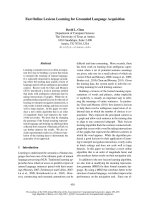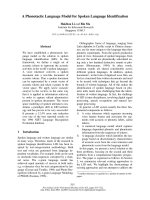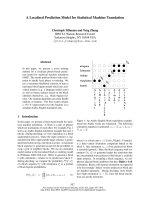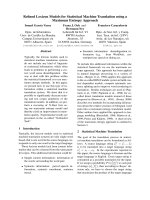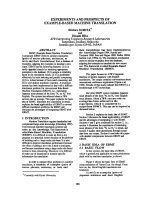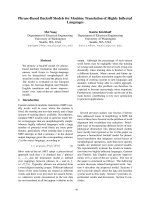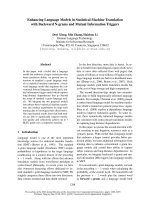Báo cáo khoa học: "Continuous Space Language Models for Statistical Machine Translation" pdf
Bạn đang xem bản rút gọn của tài liệu. Xem và tải ngay bản đầy đủ của tài liệu tại đây (497.82 KB, 8 trang )
Proceedings of the COLING/ACL 2006 Main Conference Poster Sessions, pages 723–730,
Sydney, July 2006.
c
2006 Association for Computational Linguistics
Continuous Space Language Models for Statistical Machine Translation
Holger Schwenk and Daniel Dchelotte and Jean-Luc Gauvain
LIMSI-CNRS, BP 133
91403 Orsay cedex, FRANCE
{schwenk,dechelot,gauvain}@limsi.fr
Abstract
Statistical machine translation systems are
based on one or more translation mod-
els and a language model of the target
language. While many different trans-
lation models and phrase extraction al-
gorithms have been proposed, a standard
word n-gram back-off language model is
used in most systems.
In this work, we propose to use a new sta-
tistical language model that is based on a
continuous representation of the words in
the vocabulary. A neural network is used
to perform the projection and the proba-
bility estimation. We consider the trans-
lation of European Parliament Speeches.
This task is part of an international evalua-
tion organized by the TC-STAR project in
2006. The proposed method achieves con-
sistent improvements in the BLEU score
on the development and test data.
We also present algorithms to improve the
estimation of the language model proba-
bilities when splitting long sentences into
shorter chunks.
1 Introduction
The goal of statistical machine translation (SMT)
is to producea target sentence e from a source sen-
tence f. Among all possible target sentences the
one with maximal probability is chosen. The clas-
sical Bayes relation is used to introduce a target
language model (Brown et al., 1993):
ˆ
e = arg max
e
Pr(e|f) = arg max
e
Pr(f|e) Pr(e)
where Pr(f|e) is the translation model and Pr(e)
is the target language model. This approach is
usually referred to as the noisy source-channel ap-
proach in statistical machine translation.
Since the introduction of thisbasic model, many
improvements have been made, but it seems that
research is mainly focused on better translation
and alignment models or phrase extraction algo-
rithms as demonstrated by numerous publications
on these topics. On the other hand, we are aware
of only a small amount of papers investigating
new approaches to language modeling for statis-
tical machine translation. Traditionally, statistical
machine translation systems use a simple 3-gram
back-off language model (LM) during decoding to
generate n-best lists. These n-best lists are then
rescored using a log-linear combination of feature
functions (Och and Ney, 2002):
ˆ
e ≈ arg max
e
Pr(e)
λ
1
Pr(f|e)
λ
2
(1)
where the coefficients λ
i
are optimized on a devel-
opment set, usually maximizing the BLEU score.
In addition to the standard feature functions, many
others have been proposed, in particular several
ones that aim at improving the modeling of the tar-
get language. In most SMT systems the use of a
4-gram back-off language model usually achieves
improvements in the BLEU score in comparison
to the 3-gram LM used during decoding. It seems
however difficult to improve upon the 4-gram LM.
Many different feature functions were explored in
(Och et al., 2004). In that work, the incorporation
of part-of-speech (POS) information gave only a
small improvement compared to a 3-gram back-
off LM. In another study, a factored LM using
POS information achieved the same results as the
4-gram LM (Kirchhoff and Yang, 2005). Syntax-
based LMs were investigated in (Charniak et al.,
723
2003), and reranking of translation hypothesis us-
ing structural properties in (Hasan et al., 2006).
An interesting experiment was reported at the
NIST 2005 MT evaluation workshop (Och, 2005):
starting with a 5-gram LM trained on 75 million
words of Broadcast News data, a gain of about
0.5 point BLEU was observed each time when the
amount of LM training data was doubled, using at
the end 237 billion words of texts. Most of this
additional data was collected by Google on the In-
ternet. We believe that this kind of approach is dif-
ficult to apply to other tasks than Broadcast News
and other target languages than English. There are
many areas where automatic machine translation
could be deployed and for which considerably less
appropriate in-domain training data is available.
We could for instance mention automatic trans-
lation of medical records, translation systems for
tourism related tasks or even any task for which
Broadcast news and Web texts is of limited help.
In this work, we consider the translation of Eu-
ropean Parliament Speeches from Spanish to En-
glish, in the framework of an international evalua-
tion organized by the European TC-STAR project
in February 2006. The training data consists of
about 35M words of aligned texts that are also
used to train the target LM. In our experiments,
adding more than 580M words of Broadcast News
data had no impact on the BLEU score, despite
a notable decrease of the perplexity of the target
LM. Therefore, we suggest to use more complex
statistical LMs that are expected to take better ad-
vantage of the limited amount of appropriate train-
ing data. Promising candidates are random forest
LMs (Xu and Jelinek, 2004), random cluster LMs
(Emami and Jelinek, 2005) and the neural network
LM (Bengio et al., 2003). In this paper, we inves-
tigate whether the latter approach can be used in a
statistical machine translation system.
The basic idea of the neural network LM, also
called continuous space LM, is to project the word
indices onto a continuous space and to use a prob-
ability estimator operating on this space. Since the
resulting probability functions are smooth func-
tions of the word representation, better generaliza-
tion to unknown n-grams can be expected. A neu-
ral network can be used to simultaneously learn
the projection of the words onto the continuous
space and to estimate the n-gram probabilities.
This is still a n-gram approach, but the LM pos-
terior probabilities are ”interpolated” for any pos-
sible context of length n-1 instead of backing-off
to shorter contexts. This approach was success-
fully used in large vocabulary speech recognition
(Schwenk and Gauvain, 2005), and we are inter-
ested here if similar ideas can be applied to statis-
tical machine translation.
This paper is organized as follows. In the next
section we first describe the baseline statistical
machine translation system. Section 3 presents
the architecture of the continuous space LM and
section 4 summarizes the experimental evaluation.
The paper concludes with a discussion of future
research directions.
2 Statistical Translation Engine
A word-based translation engine is used based on
the so-called IBM-4 model (Brown et al., 1993).
A brief description of this model is given below
along with the decoding algorithm.
The search algorithm aims at finding what tar-
get sentence e is most likely to have produced the
observed source sentence f. The translation model
Pr(f|e) is decomposed into four components:
1. a fertility model;
2. a lexical model of the form t(f|e), which
gives the probability that the target word e
translates into the source word f;
3. a distortion model, that characterizes how
words are reordered when translated;
4. and probabilities to model the insertion of
source words that are not aligned to any tar-
get words.
An A* search was implemented to find the best
translation as predicted by the model, when given
enough time and memory, i.e., provided pruning
did not eliminate it. The decoder manages par-
tial hypotheses, each of which translates a subset
of source words into a sequence of target words.
Expanding a partial hypothesis consists of cover-
ing one extra source position (in random order)
and, by doing so, appending one, several or possi-
bly zero target words to its target word sequence.
For details about the implemented algorithm, the
reader is referred to (D
´
echelotte et al., 2006).
Decoding uses a 3-gram back-off target lan-
guage model. Equivalent hypotheses are merged,
and only the best scoring one is further expanded.
The decoder generates a lattice representing the
724
we
I
we
should
should
must
remember
remind
remember
that
,
that
that
,
that
you
,
,
,
because
because
because
it
I
they
that
can
can
can
be
say
be
, because
can
it
they
we
that
can
can
can
be
be
have
be
have
be
have
it
it
has
forgotten
has
forgotten
has
has
forgotten
forgotten
been
forgotten
been
forgotten
forgotten
.
.
forgotten
.
.
.
.
.
.
Figure 1: Example of a translation lattice. Source
sentence: “conviene recordarlo , porque puede
que se haya olvidado .”, Reference 1: “it is ap-
propriate to remember this , because it may have
been forgotten .” Reference 2: “it is good to re-
member this , because maybe we forgot it .”
explored search space. Figure 1 shows an example
of such a search space, here heavily pruned for the
sake of clarity.
2.1 Sentence Splitting
The execution complexity of our SMT decoder in-
creases non-linearly with the length of the sen-
tence to be translated. Therefore, the source text
is split into smaller chunks, each one being trans-
lated separately. The chunks are then concatenated
together. Several algorithms have been proposed
in the literature that try to find the best splits, see
for instance (Berger et al., 1996). In this work, we
first split long sentences at punctuation marks, the
remaining segments that still exceed the allowed
length being split linearly. In a second pass, ad-
joining very short chunks are merged together.
During decoding, target LM probabilities of the
type Pr(w
1
|<s>) and Pr(</s>|w
n−1
w
n
) will be
requested at the beginning and at the end of the
hypothesized target sentence respectively.
1
This is
correct when a whole sentence is translated, but
leads to wrong LM probabilities when processing
smaller chunks. Therefore, we define a sentence
break symbol, <b>, that is used at the beginning
and at the end of a chunk. During decoding a 3-
gram back-off LM is used that was trained on text
where sentence break symbols have been added.
Each chunk is translated and a lattice is gen-
1
The symbols <s> and </s> denote the begin and end of
sentence marker respectively.
erated. The individual lattices are then joined,
omitting the sentence break symbols. Finally, the
resulting lattice is rescored with a LM that was
trained on text without sentence breaks. In that
way we find the best junction of the chunks. Sec-
tion 4.1 provides comparative results of the differ-
ent algorithms to split and join sentences.
2.2 Parameter Tuning
It is nowadays common practice to optimize the
coefficients of the log-linear combination of fea-
ture functions by maximizing the BLEU score on
the development data (Och and Ney, 2002). This
is usually done by first creating n-best lists that
are then reranked using an iterative optimization
algorithm.
In this work, a slightly different procedure was
used that operates directly on the translation lat-
tices. We believe that this is more efficient than
reranking n-best lists since it guarantees that al-
ways all possible hypotheses are considered. The
decoder first generates large lattices using the cur-
rent set of parameters. These lattices are then
processed by a separate tool that extracts the best
path, given the coefficients of six feature functions
(translations, distortion, fertility, spontaneous in-
sertion, target language model probability, and a
sentence length penalty). Then, the BLEU score
of the extracted solution is calculated. This tool is
called in a loop by the public numerical optimiza-
tion tool Condor (Berghen and Bersini, 2005). The
solution vector was usually found after about 100
iterations. In our experiments, only two cycles
of lattice generation and parameter optimization
were necessary (with a very small difference in the
BLEU score).
In all our experiments, the 4-gram back-off and
the neural network LM are used to calculate lan-
guage model probabilities that replace those of the
default 3-gram LM. An alternative would be to de-
fine each LM as a feature function and to combine
them under the log-linear model framework, us-
ing maximum BLEU training. We believe that this
would not make a notable difference in our experi-
ments since we do interpolate the individual LMs,
the coefficients being optimized to minimize per-
plexity on the development data. However, this
raises the interesting question whether the two cri-
teria lead to equivalent performance. The result
section provides some experimental evidence on
this topic.
725
3 Continuous Space Language Models
The architecture of the neural network LM is
shown in Figure 2. A standard fully-connected
multi-layer perceptron is used. The inputs to
the neural network are the indices of the n−1
previous words in the vocabulary h
j
=w
j−n+1
,
. . ., w
j−2
, w
j−1
and the outputs are the posterior
probabilities of all words of the vocabulary:
P (w
j
= i|h
j
) ∀i ∈ [1, N] (2)
where N is the size of the vocabulary. The input
uses the so-called 1-of-n coding, i.e., the ith word
of the vocabulary is coded by setting the ith ele-
ment of the vector to 1 and all the other elements
to 0. The ith line of the N × P dimensional pro-
jection matrix corresponds to the continuous rep-
resentation of the ith word. Let us denote c
l
these
projections, d
j
the hidden layer activities, o
i
the
outputs, p
i
their softmax normalization, and m
jl
,
b
j
, v
ij
and k
i
the hidden and output layer weights
and the corresponding biases. Using these nota-
tions, the neural network performs the following
operations:
d
j
= tanh
l
m
jl
c
l
+ b
j
(3)
o
i
=
j
v
ij
d
j
+ k
i
(4)
p
i
= e
o
i
/
N
r=1
e
o
r
(5)
The value of the output neuron p
i
corresponds di-
rectly to the probability P (w
j
= i|h
j
). Training is
performed with the standard back-propagation al-
gorithm minimizing the following error function:
E =
N
i=1
t
i
log p
i
+ β
jl
m
2
jl
+
ij
v
2
ij
(6)
where t
i
denotes the desired output, i.e., the prob-
ability should be 1.0 for the next word in the train-
ing sentence and 0.0 for all the other ones. The
first part of this equation is the cross-entropy be-
tween the output and the target probability dis-
tributions, and the second part is a regulariza-
tion term that aims to prevent the neural network
from overfitting the training data (weight decay).
The parameter β has to be determined experimen-
tally. Training is done using a resampling algo-
rithm (Schwenk and Gauvain, 2005).
projection
layer hidden
layer
output
layer
input
projections
shared
LM probabilities
for all words
probability estimation
Neural Network
discrete
representation:
indices in wordlist
continuous
representation:
P dimensional vectors
N
w
j−1
P
H
N
P (w
j
=1|h
j
)
w
j−n+1
w
j−n+2
P (w
j
=i|h
j
)
P (w
j
=N|h
j
)
c
l
o
i
M
Vd
j
p
1
=
p
N
=
p
i
=
Figure 2: Architecture of the continuous space
LM. h
j
denotes the context w
j−n+1
, . ,w
j−1
. P
is the size of one projection and H,N is the size
of the hidden and output layer respectively. When
short-lists are used the size of the output layer is
much smaller then the size of the vocabulary.
It can be shown that the outputs of a neural net-
work trained in this manner converge to the poste-
rior probabilities. Therefore, the neural network
directly minimizes the perplexity on the train-
ing data. Note also that the gradient is back-
propagated through the projection-layer, which
means that the neural network learns the projec-
tion of the words onto the continuous space that is
best for the probability estimation task.
The complexity to calculate one probability
with this basicversion of the neural network LM is
quite high due to the large output layer. To speed
up the processing several improvements were used
(Schwenk, 2004):
1. Lattice rescoring: the statistical machine
translation decoder generates a lattice using
a 3-gram back-off LM. The neural network
LM is then used to rescore the lattice.
2. Shortlists: the neural network is only used to
predict the LM probabilities of a subset of the
whole vocabulary.
3. Efficient implementation: collection of all
LM probability requests with the same con-
text h
t
in one lattice, propagation of several
examples at once through the neural network
and utilization of libraries with CPU opti-
mized matrix-operations.
The idea behind short-lists is to use the neural
726
network only to predict the s most frequent words,
s being much smaller than the size of the vocab-
ulary. All words in the vocabulary are still con-
sidered at the input of the neural network. The
LM probabilities of words in the short-list (
ˆ
P
N
)
are calculated by the neural network and the LM
probabilities of the remaining words (
ˆ
P
B
) are ob-
tained from a standard 4-gram back-off LM:
ˆ
P (w
t
|h
t
) =
ˆ
P
N
(w
t
|h
t
)P
S
(h
t
) if w
t
∈ short-list
ˆ
P
B
(w
t
|h
t
) else
(7)
P
S
(h
t
) =
w∈short−list(h
t
)
ˆ
P
B
(w|h
t
) (8)
It can be considered that the neural network redis-
tributes the probability mass of all the words in the
short-list. This probability mass is precalculated
and stored in the data structures of the back-off
LM. A back-off techniqueis used if the probability
mass for a input context is not directly available.
It was not envisaged to use the neural network
LM directly during decoding. First, this would
probably lead to slow translation times due to the
higher complexity of the proposed LM. Second, it
is quite difficult to incorporate n-gram language
models into decoding, for n>3. Finally, we be-
lieve that the lattice framework can give the same
performances than direct decoding, under the con-
dition that the alternative hypotheses in the lattices
are rich enough. Estimates of the lattice oracle
BLEU score are given in the result section.
4 Experimental Evaluation
The experimental results provided here were ob-
tained in the framework of an international evalua-
tion organized by the European TC-STAR project
2
in February 2006. This project is envisaged as a
long-term effort to advance research in all core
technologies for speech-to-speech translation.
The main goal of this evaluation is to trans-
late public European Parliament Plenary Sessions
(EPPS). The training material consists of the min-
utes edited by the European Parliament in sev-
eral languages, also known as the Final Text Edi-
tions (Gollan et al., 2005). These texts were
aligned at the sentence level and they are used
to train the statistical translation models (see Ta-
ble 1 for some statistics). In addition, about 100h
of Parliament plenary sessions were recorded and
transcribed. This data is mainly used to train
2
/>Spanish English
Sentence Pairs 1.2M
Total # Words 37.7M 33.8M
Vocabulary size 129k 74k
Table 1: Statistics of the parallel texts used to train
the statistical machine translation system.
the speech recognizers, but the transcriptions were
also used for the target LM of the translation sys-
tem (about 740k words).
Three different conditions are considered in
the TC-STAR evaluation: translation of the Fi-
nal Text Edition (text), translation of the tran-
scriptions of the acoustic development data (ver-
batim) and translation of speech recognizer output
(ASR). Here we only consider the verbatim condi-
tion, translating from Spanish to English. For this
task, the development data consists of 792 sen-
tences (25k words) and the evaluation data of 1597
sentences (61k words). Parts of the test data ori-
gins from the Spanish parliament which results in
a (small) mismatch between the development and
test data. Two reference translations are provided.
The scoring is case sensitive and includes punctu-
ation symbols.
The translation model was trained on 1.2M sen-
tences of parallel text using the Giza++ tool. All
back-off LMs were built using modified Kneser-
Ney smoothing and the SRI LM-toolkit (Stolcke,
2002). Separate LMs were first trained on the
English EPPS texts (33.8M words) and the tran-
scriptions of the acoustic training material (740k
words) respectively. These two LMs were then in-
terpolated together. Interpolation usually results in
lower perplexities than training directly one LM
on the pooled data, in particular if the corpora
come from different sources. An EM procedure
was used to find the interpolation coefficients that
minimize the perplexity on the development data.
The optimal coefficients are 0.78 for the Final Text
edition and 0.22 for the transcriptions.
4.1 Performance of the sentence splitting
algorithm
In this section, we first analyze the performance of
the sentence split algorithm. Table 2 compares the
results for different ways to translate the individ-
ual chunks (using a standard 3-gram LM versus
an LM trained on texts with sentence breaks in-
serted), and to extracted the global solution (con-
727
LM used Concatenate Lattice
during decoding 1-best join
Without
sentence breaks
40.20 41.63
With
sentence breaks
41.45 42.35
Table 2: BLEU scores for different ways to trans-
late sentence chunks and to extract the global so-
lution (see text for details).
catenating the 1-best solutions versus joining the
lattices followed by LM rescoring). It can be
clearly seen that joining the lattices and recalculat-
ing the LM probabilities gives better results than
just concatenating the 1-best solutions of the in-
dividual chunks (first line: BLEU score of 41.63
compared to 40.20). Using a LM trained on texts
with sentence breaks during decoding gives an ad-
ditional improvement of about 0.7 points BLEU
(42.35 compared to 41.63).
In our current implementation, the selection of
the sentence splits is based on punctuation marks
in the source text, but our procedure is compatible
with other methods. We just need to apply the sen-
tence splitting algorithm on the training data used
to build the LM during decoding.
4.2 Using the continuous space language
model
The continuous space language model was trained
on exactly the same data than the back-off refer-
ence language model, using the resampling algo-
rithm described in (Schwenk and Gauvain, 2005).
In this work, we use only 4-gram LMs, but the
complexity of the neural network LM increases
only slightly with the order of the LM. For each
experiment, the parameters of the log-linear com-
bination were optimized on the development data.
Perplexity on the development data set is a pop-
ular and easy to calculate measure to evaluate the
quality of a language model. However, it is not
clear if perplexity is a good criterion to predict
the improvements when the language model will
be used in a SMT system. For information, and
comparison with the back-off LM, Figure 3 shows
the perplexities for different configurations of the
continuous space LM. The perplexity clearly de-
creases with increasing size of the short-list and a
value of 8192 was used. In this case, 99% of the
requested LM probabilities are calculated by the
neural network when rescoring a lattice.
72
73
74
75
76
77
78
79
80
81
82
0 5 10 15 20 25 30 35
Perplexity
Number of training epochs
4-gram back-off LM
short-list of 2k
short-list of 4k
short-list of 8k
Figure 3: Perplexity of different configurations of
the continuous space LM.
Although the neural network LM could be used
alone, better results are obtained when interpolat-
ing it with the 4-gram back-off LM. It has even
turned out that it was advantageous to train several
neural network LMs with different context sizes
3
and to interpolate them altogether. In that way,
a perplexity decrease from 79.6 to 65.0 was ob-
tained. For the sake of simplicity we will still call
this interpolation the neural network LM.
Back-off LM Neural LM
3-gram 4-gram 4-gram
Perplexity 85.5 79.6 65.0
Dev data:
BLEU 42.35 43.36 44.42
WER 45.9% 45.1% 44.4%
PER 31.8% 31.3% 30.8%
Eval data:
BLEU 39.77 40.62 41.45
WER 48.2% 47.4% 46.7%
PER 33.6% 33.1% 32.8%
Table 3: Result comparison for the different LMs.
BLEU uses 2 reference translations. WER=word
error rate, PER=position independent WER.
Table 3 summarizes the results on the devel-
opment and evaluation data. The coefficients of
the feature functions are always those optimized
on the development data. The joined translation
lattices were rescored with a 4-gram back-off and
the neural network LM. Using a 4-gram back-
off LM gives an improvement of 1 point BLEU
3
The values are in the range 150. . .400. The other param-
eters are: H=500, β=0.00003 and the initial learning rate was
0.005 with an exponential decay. The networks were trained
for 20 epochs through the training data.
728
Spanish: es el nico premio Sajarov que no ha podido recibir su premio despus de ms de tres
mil quinientos das de cautiverio .
Backoff LM: it is only the Sakharov Prize has not been able toreceive theprize after three thousand
, five days of detention .
CSLM : it is the only Sakharov Prize has not been able toreceive theprize after three thousand
five days of detention .
Reference 1: she is the only Sakharov laureate who has not been able to receive her prize after
more than three thousand five hundred days in captivity .
Reference 2: she is the only Sacharov prizewinner who couldn’t yet pick up her prize after more
than three thousand five hundred days of imprisonment .
Figure 4: Example translation using the back-off and the continuous space language model (CSLM).
on the Dev data (+0.8 on Test set) compared to
the 3-gram back-off LM. The neural network LM
achieves an additional improvement of 1 point
BLEU (+0.8 on Test data), on top of the 4-gram
back-off LM. Small improvements of the word er-
ror rate (WER) and the position independent word
error rate (PER) were also observed.
As usually observed in SMT, the improvements
on the test data are smaller than those on the de-
velopment data which was used to tune the param-
eters. As a rule of thumb, the gain on the test data
is often half as large as on the Dev-data. The 4-
gram back-off and neural network LM show both
a good generalization behavior.
42.8
43
43.2
43.4
43.6
43.8
44
44.2
0 0.1 0.2 0.3 0.4 0.5 0.6 0.7 0.8 0.9 1
64
66
68
70
72
74
76
78
BLEU score
Perplexity
Interpolation coefficient
4-gram back-off LM
BLEU score
Perplexity
Figure 5: BLEU score and perplexity in function
of the interpolation coefficient of the back-off 4-
gram LM.
Figure 5 shows the perplexity and the BLEU
score for different interpolation coefficients of the
4-gram back-off LM. For a value of 1.0 the back-
off LM is used alone, while only the neural net-
work LMs are used for a value of 0.0. Using an
EM procedure to minimize perplexity of the inter-
polated model gives a value of 0.189. This value
also seems to correspond to the best BLEU score.
This is a surprising result, and has the advan-
tage that we do not need to tune the interpola-
tion coefficient in the framework of the log-linear
feature function combination. The weights of the
other feature functions were optimized separately
for each experiment. We noticed a tendency to
a slightly higher weight for the continuous space
LM and a lower sentence length penalty.
In a contrastive experiment, the LM training
data was substantially increased by adding 352M
words of commercial Broadcast News data and
232M words of CNN news collected on the Inter-
net. Although the perplexity of the 4-gram back-
off LM decreased by 5 points to 74.1, we observed
no change in the BLEU score. In order to estimate
the oracle BLEU score of the lattices we build a 4-
gram back-off LM on the development data. Lat-
tice rescoring achieved a BLEU score of 59.10.
There are many discussions about the BLEU
score being or not a meaningful measure to as-
sess the quality of an automatic translation sys-
tem. It would be interesting to verify if the contin-
uous space LM has an impact when human judg-
ments of the translation quality are used, in partic-
ular with respect to fluency. Unfortunately, this is
not planed in the TC-STAR evaluation campaign,
and we give instead an example translation (see
Figure 4). In this case, two errors were corrected
(insertion of the word ”the” and deletion of the
comma).
5 Conclusion and Future Work
Some SMT decoders have an execution complex-
ity that increases rapidly with the length of the
sentences to be translated, which are usually split
729
into smaller chunks and translated separately. This
can lead to translation errors and bad modeling
of the LM probabilities of the words at both ends
of the chunks. We have presented a lattice join-
ing and rescoring approach that obtained signifi-
cant improvements in the BLEU score compared
to simply concatenating the 1-best solutions of
the individual chunks. The task considered is the
translation of European Parliament Speeches in
the framework of the TC-STAR project.
We have also presented a neural network LM
that performs probability estimation in a contin-
uous space. Since the resulting probability func-
tions are smooth functions of the word represen-
tation, better generalization to unknown n-grams
can be expected. This is particularly interesting
for tasks where only limited amounts of appropri-
ate LM training material are available, but the pro-
posed LM can be also trained on several hundred
millions words. The continuous space LM is used
to rescore the translation lattices. We obtained
an improvement of 0.8 points BLEU on the test
data compared to a 4-gram back-off LM, which it-
self had already achieved the same improvement
in comparison to a 3-gram LM.
The results reported in this paper have been ob-
tained with a word based SMT system, but the
continuous space LM can also be used with a
phrase-based system. One could expect that the
target language model plays a different role in
a phrase-based system since the phrases induce
some local coherency on the target sentence. This
will be studied in the future. Another promis-
ing direction that we have not yet explored, is to
build long-span LM, i.e. with n much greater than
4. The complexity of our approach increases only
slightly with n. Long-span LM could possibly im-
prove the word-ordering of the generated sentence
if the translation lattices include the correct paths.
References
Yoshua Bengio, Rejean Ducharme, Pascal Vincent, and
Christian Jauvin. 2003. A neural probabilistic lan-
guage model. Journal of Machine Learning Re-
search, 3(2):1137–1155.
A. Berger, S. Della Pietra, and Vincent J. Della Pietra.
1996. A maximum entropy approach to natural
language processing. Computational Linguistics,
22:39–71.
Frank Vanden Berghen and Hugues Bersini. 2005.
CONDOR, a new parallel, constrained extension of
powell’s UOBYQA algorithm: Experimental results
and comparison with the DFO algorithm. Journal of
Computational and Applied Mathematics, 181:157–
175.
P. Brown, S. Della Pietra, Vincent J. Della Pietra, and
R. Mercer. 1993. The mathematics of statisti-
cal machine translation. Computational Linguistics,
19(2):263–311.
E. Charniak, K. Knight, and K. Yamada. 2003.
Syntax-based language models for machine transla-
tion. In Machine Translation Summit.
Daniel D
´
echelotte, Holger Schwenk, and Jean-Luc
Gauvain. 2006. The 2006 LIMSI statistical ma-
chine translation system for TC-STAR. In TC-STAR
Speech to Speech Translation Workshop, Barcelona.
Ahmad Emami and Frederick Jelinek. 2005. Ran-
dom clusterings for language modeling. In ICASSP,
pages I:581–584.
C. Gollan, M. Bisani, S. Kanthak, R. Schlueter, and
H. Ney. 2005. Cross domain automatic transcrip-
tion on the TC-STAR EPPS corpus. In ICASSP.
Sasa Hasan, Olivier Bender, and Hermann Ney. 2006.
Reranking translation hypothesis using structural
properties. In LREC.
Katrin Kirchhoff and Mei Yang. 2005. Improved lan-
guage modeling for statistical machine translation.
In ACL’05 workshop on Building and Using Paral-
lel Text, pages 125–128.
Franz Josef Och and Hermann Ney. 2002. Discrimina-
tive training and maximum entropy models for sta-
tistical machinetranslation. In ACL, pages 295–302,
University of Pennsylvania.
F J. Och, D. Gildea, S. Khudanpur, A. Sarkar, K. Ya-
mada, A. Fraser, S. Kumar, L. Shen, D. Smith,
K. Eng, V. Jain, Z. Jin, and D. Radev. 2004. A smor-
gasbord of features for statistical machine transla-
tion. In NAACL, pages 161–168.
Franz-Joseph Och. 2005. The Google statistical ma-
chine translation system for the 2005 Nist MT eval-
uation, Oral presentation at the 2005 Nist MT Eval-
uation workshop, June 20.
Holger Schwenk and Jean-Luc Gauvain. 2005. Train-
ing neural network language models on very large
corpora. In EMNLP, pages 201–208.
Holger Schwenk. 2004. Efficient training of large
neural networks for language modeling. In IJCNN,
pages 3059–3062.
Andreas Stolcke. 2002. SRILM - an extensible lan-
guage modeling toolkit. In ICSLP, pages II: 901–
904.
Peng Xu and Frederick Jelinek. 2004. Random forest
in language modeling. In EMNLP, pages 325–332.
730
